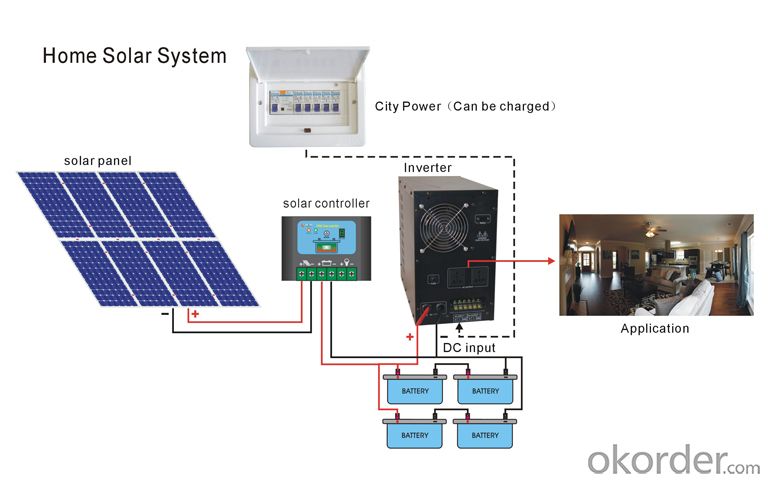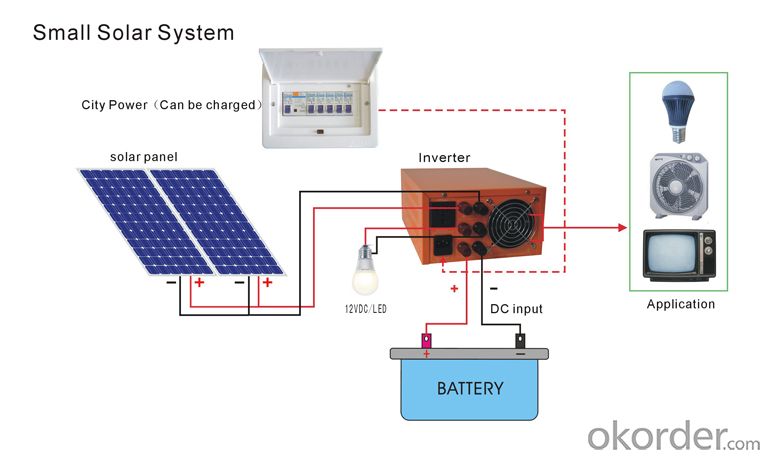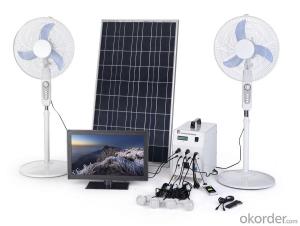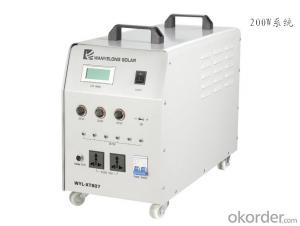200W Solar Power System Integrated Power Supply Box
- Loading Port:
- Guangzhou
- Payment Terms:
- TT OR LC
- Min Order Qty:
- 20 set
- Supply Capability:
- 10000 set/month
OKorder Service Pledge
OKorder Financial Service
You Might Also Like
Specification
1. Solar panel : crystalline silicon 100W18V, efficiency>=16%;
2. Integrated power supply box : Built-in maintenance-free lead-acid battery: 55AH12V, PWM controller: 25A12V; Pure sine wave inverter: 300W12V; 1*USB output for charging cell phone. 2*cigarette lighter output for charging DC12V fan. 4*2.5W12V output for LED lamp;
3. LED lamp : 3W12V with 5m wires and switches, 4 set;
4. Charging and using time: battery full charged time 6hours. 2 fans and 4 LED lamps totally using time 10hours;
5. Warranty: Panel 10 years; Battery 1 year; others 2 year.
Solar panel | Poly crystalline 100W 18V | |
Battery | 55AH12V lead-acid battery | |
LED lamp | 3watt, >50000 hours | |
cable of led lamp | 5m | |
Weight | 40 kg/set | |
Output | DC 12V and DC 5V,AC 110V~240V | |
Working Time | 2 fans and 4 LED lamps totally | |


Quantuty
Quality goal:Constant innovation to meet the request of the customers. Protect the environment, provide environmental products to customer.
Quality strategy:
Quality: established high efficiency quality manager system in line with ISO9001 and ISO/TS16949.
Improvement: keeping improvement & quality guarantee.
Efficiency: delivery on time, complete the agreed events with the customers on time.
Service: focus on customers, provide the service and technology support on time.
FAQ
1. How long will my inquiry get response?
Your inquiry related to our products or prices will be replied within 24 hours.
2. Can I get professional service and suggestion?
Well-trained and experienced staffs to answer all your questions in fluent English.
3. Do you accept OEM or customized design?
OEM & ODM, any your customized lightings we can help you to design and put into product.
4. What if I need specific design?
Distributorship are offered for your unique design and some our current models.
- Q:Can solar energy systems be used in commercial or industrial applications?
- Yes, solar energy systems can be used in commercial or industrial applications. In fact, many businesses and industries are increasingly adopting solar energy systems to meet their energy needs and reduce their carbon footprint. Solar panels can be installed on rooftops or open spaces of commercial or industrial buildings to generate electricity, which can then be used to power various operations and processes. Additionally, solar energy systems can also be integrated with other technologies like battery storage or solar water heating to further enhance their applicability in commercial and industrial settings.
- Q:What is the role of solar energy systems in reducing heat island effect?
- Solar energy systems can help reduce the heat island effect by generating electricity from sunlight, which reduces the reliance on fossil fuels and consequently decreases the amount of heat and air pollution emitted into the environment. Additionally, solar panels can provide shade and help to cool urban areas by absorbing and reflecting sunlight, thereby mitigating the intensity of the heat island effect.
- Q:Can solar energy systems be used in areas with limited access to solar energy demonstration projects?
- Yes, solar energy systems can still be used in areas with limited access to solar energy demonstration projects. While demonstration projects are valuable for showcasing the benefits and feasibility of solar energy, they are not a requirement for utilizing solar energy systems. With proper planning and assessment, solar energy systems can be installed and used effectively in areas with limited access to demonstration projects, helping to harness clean and renewable energy sources.
- Q:Can solar energy systems be used for powering restaurants?
- Certainly, solar energy systems can be employed to power restaurants effectively. Photovoltaic (PV) systems, also referred to as solar energy systems, convert sunlight into electricity through the utilization of solar panels. These solar panels can be positioned on the rooftop or any other suitable location to capture sunlight. Restaurants generally have substantial energy requirements due to the necessity of lighting, heating, cooling, and a variety of kitchen appliances. By making use of solar energy systems, restaurants can significantly decrease their dependence on conventional energy sources and lower their electricity expenses. The electricity generated by solar panels can be utilized to power all aspects of a restaurant's operations, encompassing lighting, refrigeration, cooking equipment, and HVAC systems. Any surplus electricity generated during peak sunlight hours can be stored in batteries for use during periods of cloudy weather or at night, ensuring a continuous power supply. Furthermore, solar energy is an environmentally friendly and sustainable power source, which implies that it has a minimal impact on the environment. By adopting solar energy systems, restaurants can demonstrate their commitment to sustainability and reduce their carbon footprint. This can also serve as a valuable marketing tool, attracting environmentally conscious customers who appreciate businesses that prioritize renewable energy. In conclusion, solar energy systems provide a feasible and effective solution for powering restaurants. They offer a dependable and sustainable source of electricity, reduce operational expenses, and showcase a commitment to environmental consciousness.
- Q:Do solar energy systems require batteries?
- Solar energy systems do not necessarily require batteries, as they can be directly connected to the electrical grid. However, batteries can be added to a solar energy system to store excess energy for later use, especially in off-grid or backup power situations.
- Q:What is the system voltage of solar panels
- System voltage refers to the number of solar panels composed of a solar power generation system, the maximum DC voltage of the power system.
- Q:What are the environmental impacts of manufacturing solar panels?
- Solar panels have both positive and negative environmental effects during their manufacturing process. On the positive side, they produce clean and renewable energy, reducing the demand for fossil fuels and mitigating greenhouse gas emissions. This helps combat climate change and air pollution, which are significant environmental concerns. However, the production of solar panels does have negative consequences. Initially, raw materials like silicon, silver, aluminum, and glass are extracted and processed, which can harm the environment. If not properly managed and regulated, mining for these materials can lead to habitat destruction, soil erosion, and water pollution. Furthermore, the manufacturing process itself requires energy, often derived from conventional power sources like coal or natural gas. This can result in carbon emissions and air pollution, offsetting some of the environmental benefits of solar energy. Additionally, the disposal of solar panels at the end of their life cycle can create environmental challenges. Most solar panels contain hazardous materials, such as lead and cadmium, which can contaminate the soil and water if not handled properly. Proper recycling and disposal methods are crucial to minimize potential harm. Despite these concerns, it is important to note that the environmental impacts of manufacturing solar panels are relatively minimal compared to the long-term benefits they provide in terms of clean energy generation and reducing greenhouse gas emissions. Continuous advancements in technology and manufacturing processes are also helping to reduce the environmental footprint of solar panel production. Overall, although there are some environmental consequences associated with manufacturing solar panels, their positive impacts on reducing carbon emissions and promoting renewable energy far outweigh the negatives. It is crucial to continue investing in research and development to improve the sustainability of solar panel production and address any potential environmental challenges.
- Q:Can solar energy systems be used off-grid?
- Yes, solar energy systems can be used off-grid. Off-grid solar systems are designed to generate and store electricity from sunlight, allowing users to power their homes or facilities without relying on the traditional power grid. These systems typically include solar panels, batteries for energy storage, and inverters to convert DC power from the panels into AC power for use. Off-grid solar systems are particularly useful in remote locations or areas with unreliable or no access to electricity, providing a sustainable and independent source of power.
- Q:Can a solar energy system be installed in an area with a high earthquake risk?
- It is entirely possible to install a solar energy system in an area prone to earthquakes, but it requires meticulous planning and engineering to ensure its stability and ability to withstand seismic activities. When installing a solar energy system in an earthquake-prone region, it is essential to consider the unique requirements of the area and adhere to local building codes and regulations. These codes often provide guidelines and specifications for constructing structures that can endure the forces of an earthquake. To minimize the risks associated with earthquakes, several measures can be taken during the installation process: 1. Foundation Design: The solar energy system must have a sturdy foundation specifically designed to withstand ground shaking. Properly anchoring the system will prevent it from toppling or sliding during an earthquake. 2. Structural Design: The structural components of the solar energy system, such as mounting frames and supports, should be engineered to endure seismic forces. Additional reinforcements like bracing or crossbars can be added to enhance stability. 3. Flexible Wiring: Electrical wiring within the solar energy system should be installed using flexible conduit and connectors. This ensures that the system can move during an earthquake without causing damage or electrical failures. 4. Maintenance and Inspections: Regular maintenance and inspections are essential to identify any potential weaknesses or damage to the solar energy system. Prompt repairs or reinforcements can then be carried out, reducing the risk of failure during an earthquake. By adhering to these guidelines and collaborating closely with experienced engineers and solar energy professionals, it is possible to install a solar energy system in an earthquake-prone area. This not only facilitates the utilization of clean and renewable energy but also contributes to the resilience and sustainability of the local energy infrastructure.
- Q:Can solar energy systems be used in areas with limited access to maintenance services?
- Yes, solar energy systems can be used in areas with limited access to maintenance services. Solar panels are relatively low-maintenance and durable, requiring minimal upkeep. They do not have moving parts that can wear out, and regular cleaning is often the only maintenance required. Additionally, advancements in technology have made solar systems more reliable and efficient, reducing the need for frequent maintenance.
1. Manufacturer Overview |
|
|---|---|
| Location | |
| Year Established | |
| Annual Output Value | |
| Main Markets | |
| Company Certifications | |
2. Manufacturer Certificates |
|
|---|---|
| a) Certification Name | |
| Range | |
| Reference | |
| Validity Period | |
3. Manufacturer Capability |
|
|---|---|
| a)Trade Capacity | |
| Nearest Port | |
| Export Percentage | |
| No.of Employees in Trade Department | |
| Language Spoken: | |
| b)Factory Information | |
| Factory Size: | |
| No. of Production Lines | |
| Contract Manufacturing | |
| Product Price Range | |
Send your message to us
200W Solar Power System Integrated Power Supply Box
- Loading Port:
- Guangzhou
- Payment Terms:
- TT OR LC
- Min Order Qty:
- 20 set
- Supply Capability:
- 10000 set/month
OKorder Service Pledge
OKorder Financial Service
Similar products
New products
Hot products
Hot Searches
Related keywords





























